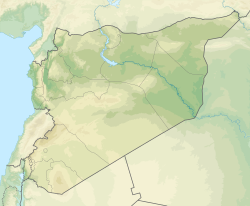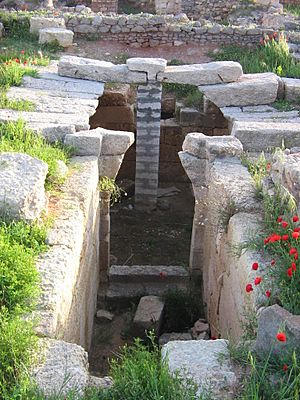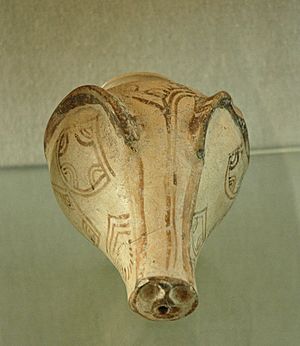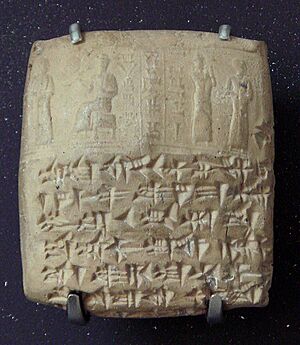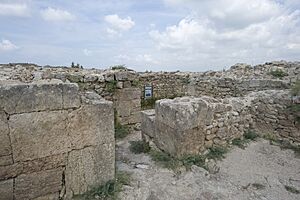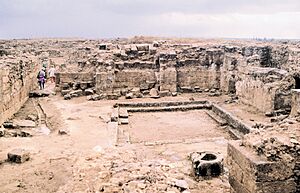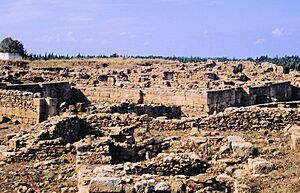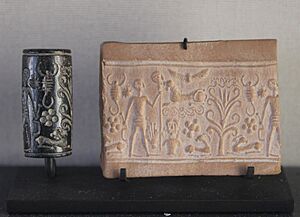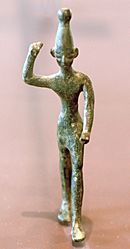Ugarit facts for kids
|
𐎜𐎂𐎗𐎚
|
|
| Alternative name | Raʾs Shamrā (Arabic: رأس شمرا) |
|---|---|
| Location | Latakia Governorate, Syria |
| Region | Fertile Crescent |
| Coordinates | 35°36′07″N 35°46′55″E / 35.602°N 35.782°E |
| Type | Settlement |
| History | |
| Founded | c. 7000 BC |
| Abandoned | c. 1185 BC |
| Periods | Neolithic, Late Bronze Age |
| Events | Bronze Age Collapse |
| Site notes | |
| Excavation dates | 1928–1939, 1950–2008 |
| Archaeologists | Claude Schaeffer Henri de Contenson, Jean Margueron, Marguerite Yon, Yves Calvet, Bassam Jamous |
| Condition | Ruins |
| Ownership | Public |
| Public access | Yes |
Ugarit ( Ugaritic: 𐎜𐎂𐎗𐎚, ủgrt /ʾUgarītu/) was an ancient port city in northern Syria about 10 kilometers north of modern Latakia. At its height it ruled an area roughly equivalent to the modern Latakia Governorate. It was discovered by accident in 1928 with the Ugaritic texts. Its ruins are often called Ras Shamra after the headland where they lie.
Contents
History
Ugarit saw its beginnings in the Neolithic period, the site was occupied from the end of the 8th millennium BC and continued as a settlement through the Chalcolithic and Bronze Ages. It was during the late bronze age that Ugarit experienced significant growth, culminating in the establishment of the Kingdom of Ugarit.
The city had close connections to the Hittite Empire, in later times as a vassal, sent tribute to Egypt at times, and maintained trade and diplomatic connections with Cyprus (then called Alashiya), documented in the archives recovered from the site and corroborated by Mycenaean and Cypriot pottery found there. The polity was at its height from c. 1450 BC until its destruction in c. 1185 BC; this destruction was possibly caused by the purported Sea Peoples, or an internal struggle. The kingdom would be one of the many that fell during the Bronze Age Collapse. Gibala (Tell Tweini), the coastal city at the southern edge of the Ugarit kingdom was also destroyed at this time.
Based on archaeological soundings, the site was occupied beginning in the eighth millennium BC. Essentially all archaeology has focused on the Late Bronze levels, so little is known about earlier occupation.
Middle Bronze Age
Middle Bronze II
Ugarit was associated with the Great Kingdom of Yamhad (Halab, Aleppo) in Northern Syria. Ugarit is also mentioned in the Mari Archive.
In the Middle Bronze, evidence indicate that Ugarit had contacts with the Egyptian Middle Kingdom. A carnelian bead can be inscribed with the name of Senusret I. A stela and a statuette from the Egyptian pharaohs Senusret III and Amenemhet III have also been found. However, it is unclear at what time these monuments were brought to Ugarit.
Late Bronze Age
The city reached its golden age between 1500 BC and 1200 BC, when it ruled a trade-based coastal kingdom, trading with Egypt, Cyprus, the Aegean (primarily Crete), Syria, the Hittites, cities of the Levant (including Ashkelon), and much of the eastern Mediterranean. Five of the Amarna letters found in Akhenaten's capital of Egypt from the mid-14th century BCE were written in Ugarit. Most of the letters were broken and their reading proved difficult, but some information was recovered. The population of Ugarit in this period is estimated to be between 7,000 and 8,000 individuals. The kingdom of Ugarit controlled about 2,000 km2 on average.
In the mid-14th century BC, Ugarit was ruled by king Ammittamru I. A letter (EA45) sent by him, probably to Amenhotep III (1388–1351 BC) expresses warm diplomatic relations between the two. During the reign of his son Niqmaddu II (c. 1350–1315 BC) Ugarit became a vassal of the Hittite Empire, mainly through the Hittite ruler's viceroy in Karkemiš and then, with the Hititte collapse, directly under Karkemiš. Diplomatic relations with Egypt continued, as evidenced by two letters sent by Niqmaddu II (EA49) and his wife Ḫeba (EA48), probably sent to Akhenaten (1351–1334 BC). The former includes a request from the Egyptian king to send a physician to Ugarit.
Destruction
| Destruction of Ugarit | |||||||
|---|---|---|---|---|---|---|---|
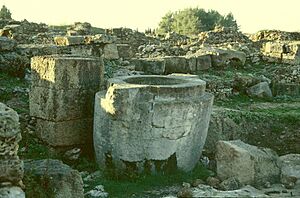 Ruins of Ugarit. |
|||||||
|
|||||||
| Belligerents | |||||||
| Ugarit | unknown (probably the Sea Peoples) | ||||||
| Commanders and leaders | |||||||
| Ammurapi | unknown | ||||||
From the late 13th century into the early 12th century BC, the entire region, based on contemporary texts, including Hititte areas, the Levant, and the eastern Mediterranean, faced severe and widespread food shortages, potentially from plant diseases. Ugarit received a number of desperate pleas for food from other realms. The food shortage eventually reached Ugarit, previously a major supplier and transporter of food supplies. A letter from Egyptian pharaoh Merenptah referred to a missive sent by the ruler of Ugarit:
So you had written to me: “Could I not have demanded my needs [from] the Great King, the king of Egypt, my lord? I demand this request: [In] the land of Ugarit there is a severe hunger (bi-ru-ú dan-niš): May my lord save [the land of Ugarit], and may the king give grain (ZÍZ.AN.MEŠ) to save my life … and to save the citizens of the land of Ugarit.
The last king of Ugarit, Ammurapi (circa 1215 to 1180 BC), was a contemporary of the last known Hittite king, Suppiluliuma II. The exact dates of his reign are unknown. However, a letter by the king is preserved, in which Ammurapi stresses the seriousness of the crisis faced by many Near Eastern states due to attacks. At this time Ugarit possessed a large army and navy and both joined with Hittite forces to try and stem the oncoming enemy, eventually having to fall back from Anatolia to the Syrian border. Ammurapi's response to an appeal for assistance from the king of Alashiya highlights the desperate situation that Ugarit and other cities faced:
My father, behold, the enemy's ships came (here); my cities(?) were burned, and they did evil things in my country. Does not my father know that all my troops and chariots(?) are in the Land of Hatti, and all my ships are in the Land of Lukka? ... Thus, the country is abandoned to itself. May my father know it: the seven ships of the enemy that came here inflicted much damage upon us.
Eshuwara, the senior governor of Cyprus, responded:
As for the matter concerning those enemies: (it was) the people from your country (and) your own ships (who) did this! And (it was) the people from your country (who) committed these transgression(s) ... I am writing to inform you and protect you. Be aware!
At the end Ammurapi begs for forces from the Hittite viceroy at Carchemish, the enemy having captured Ugarit's other port, Ra’šu, and was advancing on the city.
To the king, my lord say, thus Ammurapi, your servant.… I wrote you twice, thrice, [new]s regarding the enemy! … May my lord know that now the enemy forces are stationed at Ra’šu, and their avant-guard forces were sent to Ugarit. Now may my lord send me forces and chariots, and may my lord save me from the forces of this enemy!
The ruler of Carchemish sent troops to assist Ugarit, but Ugarit had been sacked. A letter sent after Ugarit had been destroyed said:
When your messenger arrived, the army was humiliated and the city was sacked. Our food in the threshing floors was burnt and the vineyards were also destroyed. Our city is sacked. May you know it! May you know it!
By excavating the highest levels of the city's ruins, archaeologists have studied various attributes of Ugaritic civilization just before their destruction and compared artifacts with those of nearby cultures to help establish dates. Ugarit contained many caches of cuneiform tablets inside of libraries that contained a wealth of valuable information. The destruction levels of the ruin contained Late Helladic IIIB pottery ware, but no LH IIIC (see Mycenaean period). Therefore, the date of the destruction of Ugarit is crucial for the dating of the LH IIIC phase in mainland Greece. Since an Egyptian sword bearing the name of pharaoh Merneptah was found in the destruction levels, 1190 BC was taken as the date for the beginning of the LH IIIC. A cuneiform tablet found in 1986 shows that Ugarit was destroyed sometime after the death of Merneptah (1203 BC). It is generally agreed that Ugarit had already been destroyed by the eighth year of Ramesses III (1178 BC). Recent radiocarbon work, combined with other historical dates and the eclipse of January 21, 1192, indicates a destruction date between 1192 and 1190 BC. Bay, an official of the Egyptian queen Twosret, in a tablet (RS 86.2230) found at Ras Shamra, was in communication with Ammurapi, the last ruler of Ugarit. Bay was in office from approximately 1194–1190 BC. This sets an upper limit on the destruction date of Ugarit. It is important to remember that the chronology of the ancient Near East and that of the ancient Egypt are not yet perfectly synchronized.
A large number of arrowheads were recovered from the destruction level in 2021. Their typology has not been published as yet.
Rulers
Early in the excavations a partial text of the Ugarit King List, in Ugaritic, was found. Later, complete renditions in Akkadian were discovered. They list twenty six rulers, all deified. Only the later rulers are supported by texts or known synchronisms. Given that Ugarit was abandoned between the Middle and Late Bronze Ages it is thought that the earliest names on the list were more on the order of tribal chiefs than kings.
| Ruler | Reigned | Comments |
|---|---|---|
| Niqmaddu I | Known only from a damaged seal that mentions "Yaqarum, son of Niqmaddu, king of Ugarit". | |
| Yaqarum | Known only from a damaged seal that mentions "Yaqarum, son of Niqmaddu, king of Ugarit". | |
| Ammittamru I | c. 1350 BC | |
| Niqmaddu II | c. 1350–1315 BC | Contemporary of Hittite ruler Suppiluliuma I |
| Arhalba | c. 1315–1313 BC | Contemporary of Hittite ruler Mursili II |
| Niqmepa | c. 1313–1260 BC | Treaty with Mursili II; Son of Niqmadu II; Queen was Ahatmilku |
| Ammittamru II | c. 1260–1235 BC | Contemporary of Amurru ruler Bentisina; Son of Niqmepa |
| Ibiranu | c. 1235–1225 BC | Addressee of the letter of Piha-walwi |
| Niqmaddu III | c. 1225–1215 BC | |
| Ammurapi | c. 1200 BC | Contemporary of Chancellor Bay of Egypt. Ugarit is destroyed in his reign. |
Archaeology
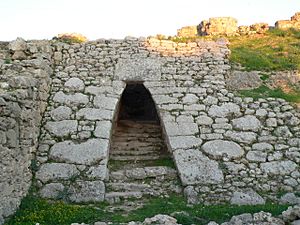
After its destruction in the early 12th century BC, Ugarit's location was forgotten until 1928 when a peasant accidentally opened an old tomb while plowing a field. At that time the region was part of the Alawite State, not in Syria. The discovered area was the necropolis of Ugarit located in the nearby seaport of Minet el-Beida. Excavations have since revealed a city with a prehistory reaching back to c. 6000 BC.
The site covers an area of about 28 hectares with a maximum height of 20 meters at the top of the acropolis. The site is surrounded by a city wall with one known fortified gate, though four gates are believed to have existed. Since the Late Bronze Age about 50 meters have been eroded from the north end of the site by the Nahr Chbayyeb river. The southern slope of the tell is covered by orange groves, preventing excavation. A brief investigation of a looted tomb at the necropolis of Minet el-Beida was conducted by Léon Albanèse in 1928, who then examined the main mound of Ras Shamra. Beginning in 1929 excavations of Ugarit were conducted by a French team called the Mission de Ras Shamra led by archaeologist Claude Schaeffer from the Musée archéologique in Strasbourg. Work continued until 1939 when it was interrupted by the outbreak of World War II.
The French excavation, now the Mission Archeologique Française de Ras Shamra-Ougarit, resumed in 1950, led again by Claude Schaeffer until 1970. At that point, directorship passed to Jean Margueron. After 44 excavation seasons all of the numerous finds and their findspots were collated. In 2005 the excavation became a joint French and Syrian effort led by Valérie Matoïan and Khozama Al-Bahloul. These continued until being ended due to the Syrian Civil War.
Archaeologists have defined a number of occupation strata at the site based on the excavations:
- Strata 1 - 500-300 BC - Helenistic up thru Arabi
- Lacuna - 900-600 BC - no occupation
- Stratum 2 - 1100-900 BC - Iron Age
- Stratum 3 - 1365-1200 BC - Late Bronze 2 = RS 1/3 = UR 3
- Stratum 4 - 1450-1365 BC - Late Bronze 1-2 = RS 1/2 = UR 2
- Stratum 5 - 1550-1450 BC - Late Bronze 1 = RS 1/1 = UR 1
- Lacuna - 1650-1550 BC - no occupation
- Stratum 6 - 1750-1650 BC - Middle Bronze '3' = RS 2/3 = UM 2
- Stratum 7 - 1900-1750 BC - Middle Bronze '2' = RS 2/2 = UM 2 = Middle Minoan 2
- Stratum 8 - 2100-1900 BC - Middle Bronze = RS 2/1 = UM 1
- Stratum 9 - 2300-2100 BC - Early Bronze 4 = RS 3/3 or III A; = UA 3
- Stratum 10 - 2500-2300 BC - Early Bronze 3 = RS 3/2 or III A 2 + 3; = UA 2
- Stratum 11 - c. 2800 BC - Early Bronze 1 - 2 = RS 3/1 or III B-C; = UA 1
- Stratum 12 - c. 3300 BC - 'Ubayd chalcolithic = RS 4 A-B (with some RS 3)
- Stratum 13 - 4000 - 3400 BC - Halaf chalcolithic = RS 4-C (4 A-B)
- Stratum 14 - c. 4000 BC - Neolithic with pottery = RS 5 A-B
- Stratum 15 - c. 4500 BC - Pre-Pottery Neolithic = RS 5-C
A number of areas lay within the fortifications of Ugarit. In the northwest section was an acropolis with the temples of Dagon and Baal. In the west was the Royal Zone, including the Royal Palace. A fortress protecting the latter area was excavated, with the earliest elements dating back to the Middle Bronze Age. To the west of that lies the modern village of Ras Shamra. There were densely populated residential areas to the east of the Royal Zone and on the southern slope of the tell.
Cuneiform tablets
Numerous cuneiform tablets have been found. By the Late Bronze age Ugarit had a thriving dual-scribal system. Primarily it used the East Semitic Akkadian language which acted as the lingua franca throughout the region for diplomacy, business, and administrative purposes. In parallel, there was scribal activity in the local Northwest Semitic Ugaritic language. A few scribes are known to have worked in both writing systems. A number of archives were found, the largest being that of the household of Urtēnu, a merchant with trading ties as far afield as Emar. This area of the tell was under military control at the time and about 100 tablets were found in the rubble from military construction. Later excavation found several hundred tablets in the actual home. One tablet mentions the enthronement of Kassite ruler Kadashman-Harbe II (c. 1223 BC) whose rule lasted less than a year, allowing a tight synchronism. The latest datable text was from the reign of Kassite ruler Meli-Shipak II (c. 1186–1172 BC) about the time of the destruction of Ugarit. An example of the archive involving one ton of copper:
Thus Kušmešuša, king of Alašiya, say to Niqmaddu, king of Ugarit, my son. All is well with me, my households, my countries, my wives, my sons, my troops, my horses and my chariots.… In exchange of the gift which you had sent me, I sent to you thirty-three (ingots of) copper; their weight is thirty talents and six-thousand and five-hundred shekels.
One small tablet written in Cypro-Minoan was found on the surface of the tell. While it traditionally has been assumed that syllabic texts are in the Akkadian language and alphabetic texts are in Ugaritic it has been suggested that much of the syllabic writing, especially in administrative documents, is actually in "a jargon where an Akkadian dialect is hard to detect given the great amount of Ugaritic elements it contained".
Royal palace
The Royal Palace was constructed over several major phases between the 15th and 13th centuries BC. It comprised rooms arranged around courtyards, encompassing 6,500 square meters before the city's destruction in the early 12th century BC. A tablet from the 14th century BC found in the Amarna archives, EA 89, Rib-Hadda of Byblos likening the palace at Tyre to the grandeur found in the palace within Ugarit's walls. The palace was well constructed, predominantly crafted from stone, with preserved ashlar blocks reaching heights of up to 4 meters. Wooden crossbeams were also incorporated, inserted into slots within the stone masonry. A thick layer of plain plaster covered the walls. To the west of the palace was a set aside 10,000 square meter Royal Zone.
Archaeological findings within the ruins have included a variety of artifacts including ivory carvings, stone stele, figurines, and numerous tablets. These tablets were discovered in archives located across the palace; their contents encompass reports on outlying regions, judicial records—particularly from the south-central archives of the palace—and examples of practice writing by young scribes. Below ground, beneath two northern rooms, lay family tombs—three large chambers constructed with corbelled vaults—found devoid of any contents. The vanished upper floor likely accommodated the private quarters of the royal family, accessed via twelve staircases.
Acropolis
The Acropolis, positioned in the Ugarit's northeastern section, housed the city's primary temples dedicated to Baal and his father, Dagan. Though the existing remnants date to the Late Bronze Age, these temples might have their origins in the Middle Bronze Age. Stelai discovered in this area portray or name these gods, affirming their identification for the respective cults. Within the Temple of Baal, discoveries include the Baal with Thunderbolt depicting Baal holding a club aloft, portrayed in a typical Near Eastern and Egyptian artistic style as well as a stela bearing a dedication to Baal of Sapan. Numerous statues, stelai—some offered by Egyptians—and sixteen stone anchors were found as votive offerings in this vicinity.
Both temples are composed of a pronaos (porch) and a naos (sanctuary proper), aligned from north-northeast to south-southwest. The Temple of Dagan has 4–5-meter-thick foundation walls. Remnants of the Temple of Baal encompass sections of an enclosing wall, a likely courtyard altar, monumental steps leading to the elevated pronaos and naos, and another presumed altar within the naos. The temple was destroyed, possibly by an earthquake, in the mid 13th century and not rebuilt. The Temple of Dagan was also destroyed at that time but was rebuilt.
Another significant structure within the Acropolis was the House of the High Priest, situated west of the Temple of Dagan. This large, two-story residence, largely well-constructed, contained tablets containing mythological poems. Some tablets demonstrated writing exercises and included syllabic and bilingual lexicons, implying the building's use as a center for scribe training. Its proximity to the primary temples and the discovery of bronze tools, particularly four small adzes and a dedicated hoe, hints at its potential role as the residence of the city's chief priest. Among a cache of seventy-four bronze items uncovered beneath a doorway threshold inside the house, was an elegant tripod adorned with pomegranate-shaped pendants.
Ras Ibn Hani and Minet el Beida
Two nearby areas, Ras Ibn Hani and Minet el Beida, parts of the city of Ugarit, have also been excavated. Ras Ibn Hani, on a promontory overlooking the Mediterranean 5 kilometers south of the city, was discovered during commercial construction in 1977. Salvage excavation occurred in 1977 followed by regular excavation which has continued to the present by a Syrian-French team led by A. Bounni and J. Lagarce. Occupation began in the mid-13th century BC. Abandoned along with Ugarit, it was re-occupied in the Hellenistic period, including the construction of a defensive fortress. A "royal palace", elite housing, and tombs were found. About 169 cuneiform tablets, most in the Ugaritic language, were also found.
One of the two ports of ancient Ugarit (the other, Ra’šu, is unlocated but suggested to be Ras Ibn Hani) was located 1.5 kilometers west of the main city, at the natural harbor of Minet el Beida (Arabic for "White Harbor"). The 28 hectare site was excavated between 1929 and 1935 by Claude Schaeffer. The site is currently a military port and unavailable for excavation. Its name in the Late Bronze Age is believed to have been Maʾḫadu. Archaeological excavations carried out on the southern side of the bay, now reduced in size due to alluvial fill, unveiled remnants of a settlement established in the 14th century BC, and perhaps earlier, in the late 15th century. This port town, featuring an urban layout akin to the city of Ugarit, displays irregular street formations. Dwellings were structured around courtyards with adjacent rooms, including provisions like wells, ovens, and occasionally subterranean tombs. Besides residential spaces and shrines, warehouses were present for storing diverse goods earmarked for import or export. One of them was discovered still housing eighty shipping jars that remain remarkably intact.
Artifacts discovered in the port indicate the predominance of native Ugaritians within the local populace, accompanied by a significant presence of various foreign communities such as Egyptians, Cypriots, Hittites, Hurrians, and Aegean peoples. Among the discoveries were Cypriot pottery (both imported and locally crafted), Mycenaean pottery, ivory cosmetic containers from Egypt, a terracotta depiction of Hathor, bronze tools and weaponry, cylinder seals, stone weights, remnants of banded dye-murex shells used in the production of purple dye, and inscribed tablets.
The site is thought to have been largely evacuated before it was burned (resulting in a thick ash layer) and destroyed as few valuables were found in the residences or in the southern palace. About 130 cuneiform tablets were found in the northern palace. After the destruction the site was occupied by simple residences, termed a village by the excavators. Aegean style pottery and loom weights were found in this Iron Age I level.
Language and literature
Alphabet
Scribes in Ugarit appear to have originated the "Ugaritic alphabet" around 1400 BC: 30 letters, corresponding to sounds, were inscribed on clay tablets. Although they are cuneiform in appearance, the letters bear no relation to Mesopotamian cuneiform signs; instead, they appear to be somehow related to the Egyptian-derived Phoenician alphabet. While the letters show little or no formal similarity to the Phoenician, the standard letter order (seen in the Phoenician alphabet as ʔ, B, G, D, H, W, Z, Ḥ, Ṭ, Y, K, L, M, N, S, ʕ, P, Ṣ, Q, R, Š, T) shows strong similarities between the two, suggesting that the Phoenician and Ugaritic systems were not wholly independent inventions. A Unicode block for Ugaritic has been defined.
Ugaritic language
The existence of the Ugaritic language is attested to in texts from the 14th through the 12th century BC. Ugaritic is usually classified as a Northwest Semitic language and therefore related to Hebrew, Aramaic, and Phoenician, among others. Its grammatical features are highly similar to those found in Classical Arabic and Akkadian. It possesses two genders (masculine and feminine), three cases for nouns and adjectives (nominative, accusative, and genitive); three numbers: (singular, dual, and plural); and verb aspects similar to those found in other Northwest Semitic languages. The word order in Ugaritic is verb–subject–object (VSO) and subject-object-verb (SOV); possessed–possessor (NG) (first element dependent on the function and second always in genitive case); and noun–adjective (NA) (both in the same case (i.e. congruent)).
Ugaritic literature
Apart from royal correspondence with neighboring Bronze Age monarchs, Ugaritic literature from tablets found in the city's libraries include mythological texts written in a poetic narrative, letters, legal documents such as land transfers, a few international treaties, and a number of administrative lists. Fragments of several poetic works have been identified: the "Legend of Keret", the "Legend of Danel", the Ba'al tales that detail Baal-Hadad's conflicts with Yam and Mot, among other fragments.
See also
 In Spanish: Ugarit para niños
In Spanish: Ugarit para niños
- Asherah
- Cities of the ancient Near East
- Elohim (gods)
- Short chronology timeline
- Ugaritic mythology


